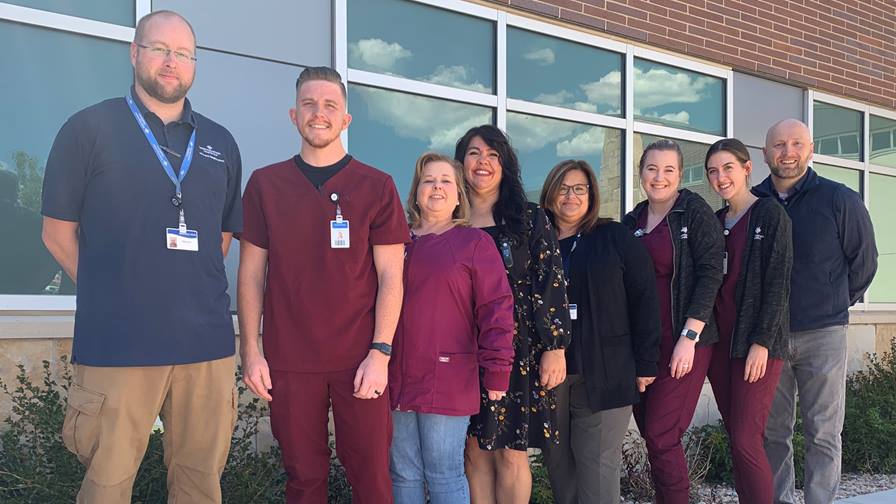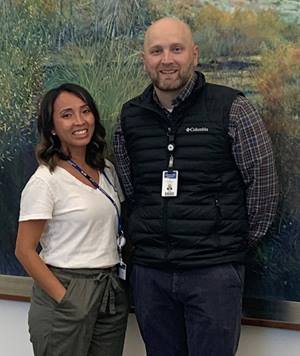Since late 2020 when Adam Thompson arrived at Heber Valley Hospital as the manager of the Lab Services team, influencing the experience for Lab patients has been a journey of understanding and collaboration.


Ursula Melby and Adam Thompson
Intermountain captures and monitors patient experience using surveys sent following a visit. These surveys roll up into the Likelihood to Recommend (LTR) score. LTR scores at Heber Valley's lab have improved 86 percentile rank points since Q4 2021 and are currently at the 93rd percentile. Because they’re such an important window into our patient’s experience, they’re also an Intermountain Key Performance Indicator (KPI).
“KPIs can seem detached from the personal aspect of care,” Adam says. “What LTR means to us is how the community perceives us, and how much patients value their experience with us. These experiences matter because they establish better connections and trust within the community.”
Adam remembers rallying the team because he knew they could do better for patients.
“First, we looked at what we could control,” says Adam. “When we looked at the data, patient wait times were a problem. I think it had to do with growth.” Heber Valley’s lab volume has increased by 50% over the past five years.
“We worked with our hospital administrator and finance director to add a phlebotomist position justified by that increase in patients,” says Adam.
Next, Adam and Ursula Melby, the on-site patient access supervisor at Heber Valley, collaborated to look at what patients were experiencing.
“Our patient survey responses let us know we didn’t have an efficient process for the patient,” says Si Hutt, Heber Valley Hospital administrator. “We just needed to observe what our patients were experiencing. That led Adam and Ursula to the right answers.”
“When a patient has a problem with one aspect of their experience, they generally lower the overall score,” says Adam. Patient comments highlighted registration pain points.
Heber Valley Hospital adopted a new tool early last year called Phreesia.
“This tool allows patients to complete registration themselves, electronically through their own mobile device, the hospital kiosk or iPad,” Ursula says.
The goal was to move 80% of the registration, a process managed by Intermountain partner R1 RCM, into the hands of patients prior to arriving and reduce patient contact with caregivers at check-in during COVID. One difference was clear.
“Some people—generally a younger population—liked the new process,” says Adam. “Older patients had a harder time.”
“We needed a solution even if it was counter to the goal,” says Ursula. “We asked, ‘what can we do to make it a more caring experience?’ We listened to patients and the Lab team. We wanted to do what was right for people.”
“Respectfully speaking with a patient rather than just looking at numbers, elevated understanding,” Adam says.
“Instead of passing the iPad to a patient, we said ‘come, sit down, we’ll guide you,’” Ursula says.
“Talking with someone goes a long way to calm nerves and help you have a better experience.”
Registration time went from 10 minutes on average to 1 minute today. Patient experience scores year-to-date are 86% and month-to-date are 99%—within the top three highest scores in the Intermountain system overall and number one based on volume.
Ursula and Adam had the same goal: to see their individual teams act as one team for the patient while creating a great place to work.
“A big roadblock was the past relationship between our teams,” says Adam. “We wanted to better understand the pressures that R1 managers were under. Improving our relationship was big in our success. With Ursula, it was a fresh start to focus improving the process.”
“It was important to be open-minded,” Ursula adds.
“Patient experience improvement efforts at Heber go beyond the Lab or any one department, says Mike Smith, Laboratory Shared Services operations director. “Our Lab and R1 leaders recognize that interdepartmental collaboration is key. They touch base daily to review comments, staffing, and wait times. They listen to the patients and consistently provide a more caring, respectful experience.”
Ursula and Adam’s teams also adopted radical transparency in their communication, asking tough questions and listening.
“We talk through issues with co-workers to work them out together,” says Spencer Arnold, register/cashier with R1. “We don’t think of Intermountain and R1 separately. We’re all the same team.”
Brendan Coon, a phlebotomist who joined the team last year agrees. “We don’t see us versus them. We’re one team. It’s pretty sweet!”
One of Intermountain’s strengths comes from applying system expertise and resources with a community focus.
“Adam is part of a team within Laboratory Shared Services that meets regularly to learn from each other,” says Mike. “Other sites have made similar improvements as best practices are shared.”
“My job is to set the tone, define process,” says Adam. “There are other strong leaders on my team. Ursula and her team have shown leadership, courage, and initiative. There’s team ownership all around.”
“The things we’ve done to make a difference can be done anywhere,” Adam says. He suggests:
- Focus on people by aligning personal and professional motivations versus just addressing the process.
- Listen to the consumer, to the patient. Try to see things from their perspective with caring and respect.
- Work together across departments, teams, and facilities.
“LTR scores are a metric that reflects how well we are meeting or exceeding our patient’s expectations,” says Si. “An extraordinary experience for our patients depends on a consistent focus by every team member for every patient every time.”
“To our patients, our phlebotomists are the face of the lab and deserve a ton of credit,” says Adam. “Great patient experiences cannot be achieved without great people, no matter how aligned your processes are.”
“My staff is fantastic and have gone above and beyond,” Ursula says. “We like knowing that we’re doing a good job.”

